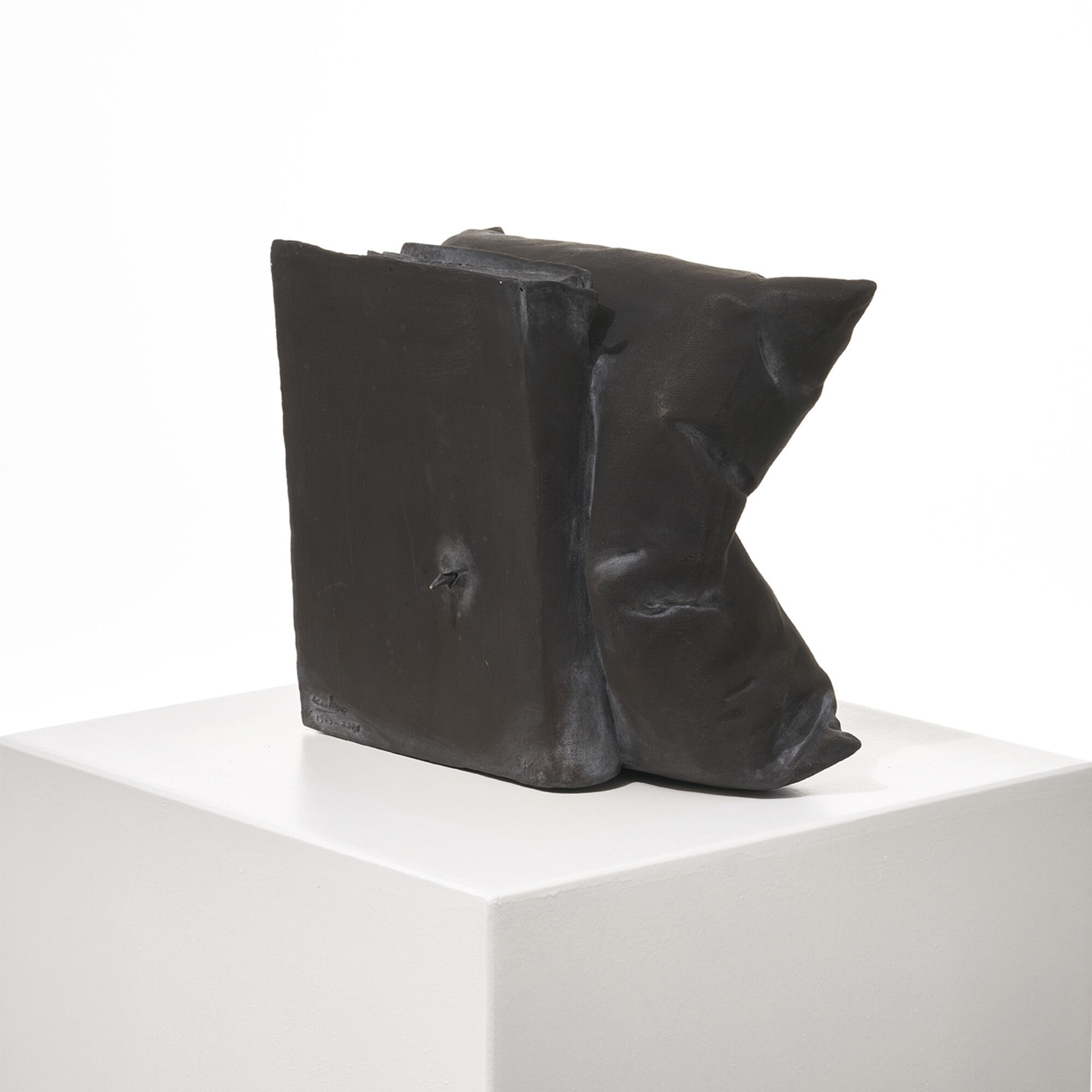Sculpture "Untitled (Cushion + Book) - Dark" (1969/2021), bronze
Sculpture "Untitled (Cushion + Book) - Dark" (1969/2021), bronze
Quick info
limited, total 25 copies | numbered | signed | dated | bronze | size 48 x 16.5 x 14.5 cm (h x w x d)
Detailed description
Sculpture "Untitled (Cushion + Book) - Dark" (1969/2021), bronze
During a trip to Bhutan in 1968, Uecker encountered the ritual of the monks there placing their prayer books under their pillows. This inspired him a year later to create a sculpture that combines these elements, but - typical for Uecker - adds a nail.
This quote by the artist is explanatory: "To make the course of a movement visible, as a state of aliveness in which the human being participates in creative repetition, in monotony, is indeed an exciting activity that can be experienced spiritually like a prayer.
The bronze presented here was created after the unique piece from 1969 and was published in a small edition of 19 copies.
Sculpture in bronze, 1969/2021. Edition: 19 copies numbered with Arabic numerals (offered here) + 6 copies numbered in Roman numerals, signed and dated by hand. Height: 48 cm. Width: 16.5 cm. Depth: 14.5 cm.

About Günther Uecker
Günther Uecker was born in Wendorf, Germany in 1930 and is a German painter and object artist with an international reputation. He is best known for his relief-like nail art.
As early as 1957, Uecker created his nail works on white canvases, which were to become characteristic of his art from then on. He arranged the nails in symmetrical formations boards. Through the arrangement of the nails and the alternation of light and shadow, the nail reliefs achieve a dynamic effect. The white background gives the nails a dematerialising effect.
From 1976 to 1995 Uecker taught as a professor at the Düsseldorf Art Academy. In 1999 he designed the prayer room for the rebuilt Reichstag building in Berlin. Important awards and exhibitions in major museums and collections all over the world, such as the Museum of Modern Art, New York, pay tribute to his work. In 2015, the Kunstsammlung Nordrhein-Westfalen hosted a major exhibition dedicated to the co-founder of the legendary artist group ZERO, focusing on the various facets of Uecker's extensive oeuvre.
List of selected prizes and awards:
- first prize of the 4th San Marino Biennale for ZERO and Group N (1963)
- prize of the Young Biennale in Paris (1964)
- sponsorship prize of the state of North Rhine-Westphalia (1964)
- critics' prize of the São Paulo Biennale (1971)
- Kaiserring of the city of Goslar (1983)
- Order of Merit of the Federal Republic of Germany Cross of Merit 1. Class (1985)
- The Pour le Mérite (2000)
- State Prize of North Rhine-Westphalia (2015)
His oeuvre includes object art, painting, installations, stage designs and films.
An alloy of copper with other metals (especially with tin) used since ancient times.
When casting bronze, the artist usually applies the lost-wax technique which is dating back more than 5000 years. It's the best, but also the most complex method of producing sculptures.
First, the artist forms a model of his sculpture. It is embedded in a liquid silicone rubber mass. Once the material has solidified, the model is cut out. The liquid wax is poured into the negative mould. After cooling down, the wax cast is removed from the mould, provided with sprues and dipped into ceramic mass. The ceramic mass is hardened in a kiln, whereby the wax flows out (lost mould).
Now we finally have the negative form, into which the 1400° C hot molten bronze is poured. After the bronze had cooled down, the ceramic shell is broken off and the sculpture is revealed.
Now the sprues are removed, the surfaces are polished, patinated and numbered by the artist himself or, to his specifications, by a specialist. Thus, each casting becomes an original work.
For lower-quality bronze castings, the sand casting method is often used which, however, does not achieve the results of a more complex lost-wax technique in terms of surface characteristics and quality.
Contemporary art created from objects that are not normally considered materials from which art is made.
Object art was a means of expression of Cubism, Dadaism and Surrealism, and in the course of their development to the present day had spawned various presentation techniques.
A plastic work of sculptural art made of wood, stone, ivory, bronze or other metals.
While sculptures from wood, ivory or stone are made directly from the block of material, in bronze casting a working model is prepared at first. Usually, it is made of clay or other easily mouldable materials.
The prime time of sculpture after the Greek and Roman antiquity was the Renaissance. Impressionism gave a new impulse to the sculptural arts. Contemporary artists such as Jorg Immendorf, Andora, and Markus Lupertz also enriched sculptures with outstanding works.









